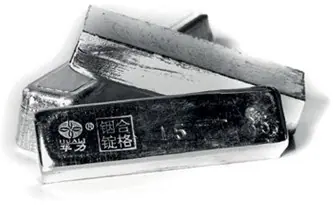Indium Prices
The current price of Indium is $832.90 per kg.
Please note that the price provided is the retail price for private investors and is aligned with industry retail pricing. For bulk purchases, whether investment or industry, please contact us for a quotation.
Table: Indium Historical Prices and Price Changes
| Date | Indium Price | Change % to Today | Annual Change % |
|---|---|---|---|
| Jan 05 2026 | $832.90 / kg | ||
| Jan 1 2026 | $832.90 / kg | 0.00% | |
| Jan 1 2025 | $698.80 / kg | +19.19% | +19.19% |
| Jan 1 2024 | $561.60 / kg | +48.31% | +23.18% |
| Jan 1 2023 | $442.30 / kg | +88.31% | +26.97% |
| Jan 1 2022 | $477.10 / kg | +74.58% | -7.26% |
| Jan 1 2021 | $315.10 / kg | +164.33% | +51.41% |
| Jan 1 2020 | $315.11 / kg | +164.32% | 0.00% |
| Jan 1 2019 | $428.61 / kg | +94.33% | -26.48% |
| Jan 1 2018 | $380.10 / kg | +119.13% | +12.76% |
Indium Historical Price Movement
At today’s price of $832.90 per kg, indium has changed 0.00% since the start of 2026. It gained 19.19% last year and is up +48.31% since Jan 1st 2024, and +88.31% since Jan 1st 2023 (when it was priced $442.30 per kg).
This strategic metal increased +164.33% in value since Jan 1st 2021, when the cost of indium was $315.11 per kg. If we go back to Jan 1st 2018, when the price of indium was $380.10 per kg, the value increased by +119.13%.
Indium is a rare, malleable, and easily workable metallic element with the atomic number 49 and the symbol In. It has a silvery-lustrous gray appearance and is considered one of the least abundant elements in earth’s crust.
Uncovering the various applications of indium and who produces it first helps us predict its future price more accurately (jump to the forecast).
Indium Uses

Indium is one of the most versatile and strategically important metals in the modern economy. Its unique combination of softness, conductivity, and transparency makes it indispensable across multiple industries; from consumer electronics and renewable energy to aerospace, automotive, and medical technology.
Electronics & Displays
The largest share of global indium demand, around two-thirds, comes from Indium Tin Oxide (ITO) coatings used in LCD, OLED, and touchscreen displays. ITO allows glass to be both transparent and electrically conductive, an essential property for everything from smartphones, tablets, and televisions to automotive dashboards and smart windows.
As the world continues to digitize, ITO remains the quiet enabler behind most interactive screens.
Renewable Energy & Advanced Semiconductors
Indium also plays a key role in the energy transition and high-speed communications. It forms part of CIGS thin-film solar cells, helping convert sunlight into electricity efficiently. In parallel, compounds such as indium phosphide (InP) and indium gallium arsenide (InGaAs) are essential in 5G networks, AI data centers, and optical communication systems, all fast-growing markets with strategic importance for national security and digital infrastructure.
Aerospace, Automotive & Industrial Applications
Thanks to its low melting point, malleability, and corrosion resistance, indium is widely used in solders, sealing materials, and heat-transfer interfaces. These characteristics make it valuable in aerospace engineering, automotive electronics, and precision cooling systems where performance under thermal stress is critical. Indium alloys improve reliability in mission-critical environments, from satellites to electric vehicles.
Medical & Specialized Uses
The radioisotope Indium-111 is used in diagnostic imaging and targeted cancer treatments, while indium’s biocompatibility lends itself to implants and biomedical sensors. Beyond healthcare, indium’s softness and non-reactivity make it ideal for vacuum seals, cryogenic applications, and specialized coatings that protect sensitive surfaces from corrosion or oxidation.
Where is Indium Produced?
Although indium occurs in trace quantities in many mineral deposits, almost all commercially produced indium is a by-product. Primarily of zinc ore processing and sometimes also from copper sulfide smelting. It’s typically present at ~0.1 % or less in zinc (sphalerite) ores and must be separated via leach, solvent extraction, and electrorefining steps.
Today, the world’s indium supply is heavily concentrated. China remains the dominant producer, accounting for about 70 % of global refined indium output as of the 2025 USGS summary. Other contributors include South Korea, Canada, and Japan, though their output is far smaller and often tied to refining/processing of byproducts from existing operations.
Because indium is a by-product, its supply is captive to zinc and copper mining economics; you can’t simply “turn on” indium mines standalone.

What Factors Determine the Price of Indium?
Simply put, the law of supply and demand determines the price of indium (like it does with other commodities).
Indium has become a key asset for many industries. Increased demand for end products from those industries (e.g., smartphones, AI datacentres, aircraft, or solar cells) would increase the demand for this prized commodity.
In terms of supply, indium is considered rare when considering its availability on earth. It makes up just one part per million of the earth’s crust, making it much less abundant than more common elements such as copper and aluminum.
Indium Price Forecast
At a glance
Indium continues to perform strongly within the strategic metals group. Indium prices rose 26.97% in 2023, 23.18% in 2024, and 19.19% in 2026. This steady appreciation reflects a mix of tight supply, policy friction, and growing technological demand.
The most significant change came in February 2025, when China introduced export licensing requirements for indium and several other critical materials. While not an outright ban, this move effectively slowed export flows and created new paperwork hurdles for refiners (see Reuters article).
Given that China remains by far the dominant source of refined indium, such controls have amplified price volatility and reinforced concerns about global supply concentration.
At the same time, Indium Tin Oxide (ITO) coatings continue to represent the backbone of demand, enabling the world’s touchscreens, flat-panel displays, and smart glass technologies.
But indium’s future is not limited to consumer electronics: compounds like indium phosphide (InP) and indium gallium arsenide (InGaAs) are gaining traction in AI-driven optical communications and high-speed data networks, while CIGS thin-film solar cells help power the clean-energy transition. These sectors align with long-term policy support under frameworks such as the European Critical Raw Materials Act.
The U.S. Geological Survey’s 2025 Indium Summary further highlights these dynamics, noting that indium’s role in semiconductors, solar technology, and communications continues to expand, particularly as data-center infrastructure and renewable-energy targets accelerate worldwide (USGS 2025 Indium overview).
With supply still concentrated and downstream demand broadening, the medium-term outlook for indium remains constructively firm.
What changed in 2025
Export licenses in China (effective February 2025) introduced a new layer of bureaucracy that constrained availability outside China and widened price differentials between Chinese and Western buyers.
Policy support intensified: the EU’s CRM Act and U.S. critical-materials programs both reaffirmed indium’s status as a strategic resource, unlocking funding for mapping, recycling, and friend-shoring projects.
Stockpiling interest increased: defense and industrial programs in the West began to evaluate indium as part of broader material-security strategies, keeping baseline demand resilient even through market lulls.
What this means for indium
A market that was already tight has effectively become administratively constrained. Supply frictions now act as a semi-permanent feature rather than a temporary shock. Meanwhile, the rise of AI, 5G, and renewable-energy infrastructure continues to expand indium’s use beyond its traditional base in displays, ensuring that even modest demand growth meets a structurally limited supply pool.
Price drivers tilting upward
China’s export-license cadence, which sets the tempo of refined indium supply.
ITO’s dominance across touchscreens and smart glass applications, providing a solid consumption base.
Emerging semiconductor uses in data-center optics and next-generation communications hardware.
Supportive policy environment under EU and U.S. critical-materials initiatives that encourage stockpiling and diversification of supply.
Potential headwinds to watch
Display-cycle softness if global electronics demand slows temporarily.
R&D into ITO alternatives such as conductive polymers or metal-mesh coatings. However, none are yet commercially disruptive, but always a watch point.
Trade-policy volatility, with tariff shifts or counter-measures potentially delaying procurement cycles.
6–12 month forecast view
Bias: Cautiously firm (baseline: sideways-to-higher)
Rationale:
China’s new licensing regime continues to limit export flow and create a “sticky” supply environment.
Strategic and policy-driven buying interest remains elevated amid geopolitical uncertainty.
Core ITO demand is stable enough to absorb minor inventory fluctuations.
12–24 month forecast view
Bias: Gradual grind higher with volatility
Rationale:
Policy frameworks like the EU Critical Raw Materials Act and U.S. supply-chain initiatives provide a durable tailwind.
Expanding indium-phosphide demand from optical transceivers and photonics adds incremental growth.
Periodic volatility is likely due to export license timing and display cycles shifting quarter-to-quarter.
3–5 year forecast view
Bias: Constructive, supply-constrained upside case
Rationale:
Concentrated refining and persistent export oversight point to a sustained structural premium.
A broader end-use mix, including ITO, InP optics, and thin-film solar, diversifies and deepens demand.
Project lead times for non-Chinese refining capacity stretch over multiple years, limiting downside risk.
Why physical indium fits the Strategic Metals Invest playbook
Scarce, policy-sensitive supply: bureaucratic or political friction can cause prices to rise faster than new supply can respond.
Strategic classification: inclusion in the EU CRM Act and U.S. critical-materials programs underscores its long-term importance.
Technological stickiness: indium’s role in screens, semiconductors, and solar technology ensures demand is structural, not cyclical.
How and Where to Buy Indium
Businesses like Apple, Samsung, Boeing, and Tesla turn to globally licensed market metals dealers when they require indium. These trusted intermediaries are the connecting link between high-tech industries and the producers of rare earths & strategic metals that enable them to produce innovative results.
You can also purchase smaller amounts of this valuable metal through online platforms such as eBay, Alibaba, or Amazon. However, this is only a viable solution for hobbyists rather than for industry or investors.
Reputable metals dealers like ourselves offer full chain-of-custody verification guaranteeing quality purity (min. 99.995%). We also facilitate storage under ideal industrial conditions so discerning investors can ensure long-term security and success when buying this precious material as an investment.
Indium futures contracts are traded in the Shanghai Metal Market (SMM) too.
How and Where to Sell Indium
The only viable option for those wishing to offload industrial-grade indium is to use reputable industry suppliers. That’s because only they can provide the chain of custody documents and analysis reports needed by serious buyers like LG, General Motors, Hisense, and Honda.
If you bought some indium on an online marketplace, you’re only option is to sell it again to some other enthusiast on eBay, Amazon, or Alibaba. You will unlikely get market rates, making it challenging to realize profits from future price gains.
On the other hand, we can guarantee the safe and fast liquidation of the strategic metals of our investors at market rates because we’re an industry supplier.
All prices on this page last updated Jan 05 2026.


